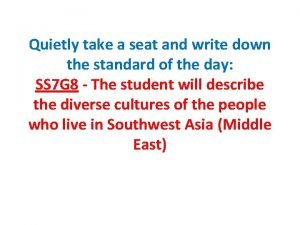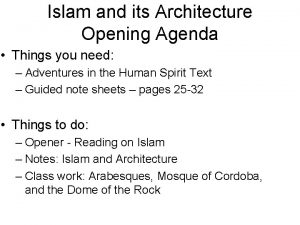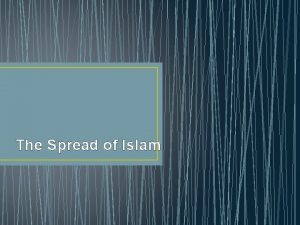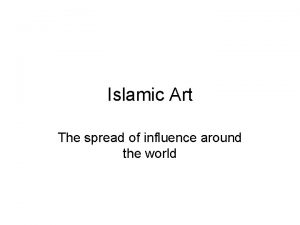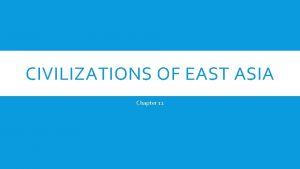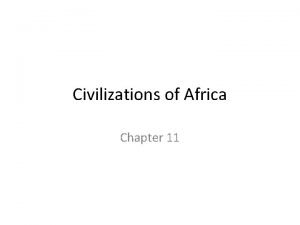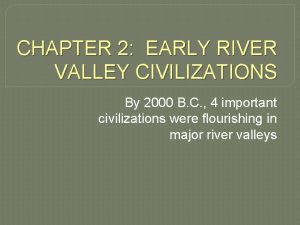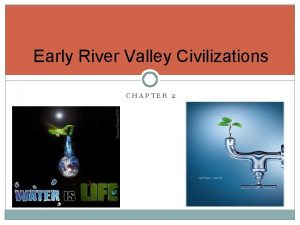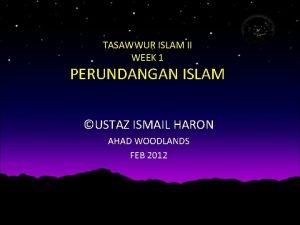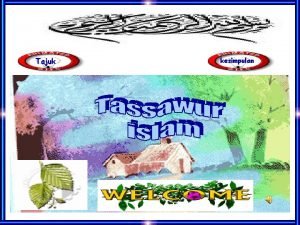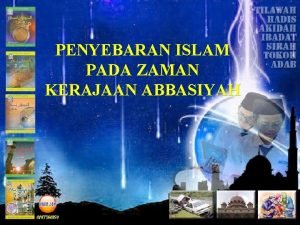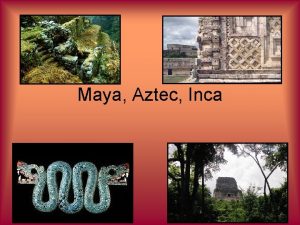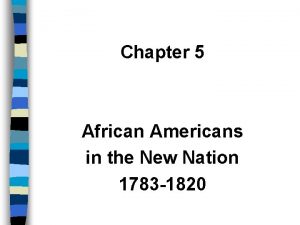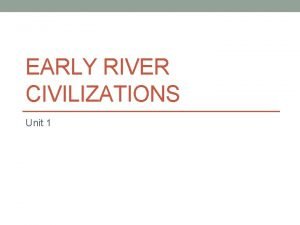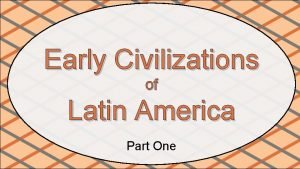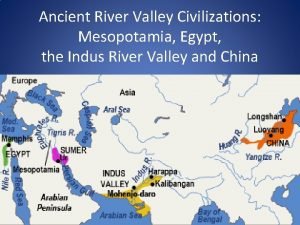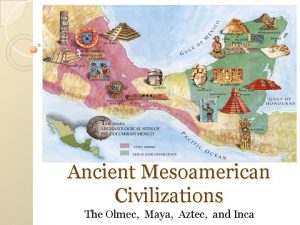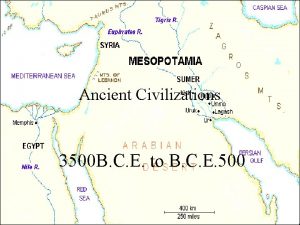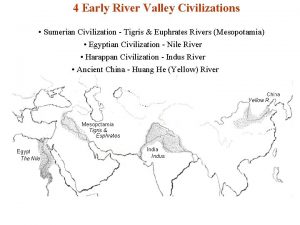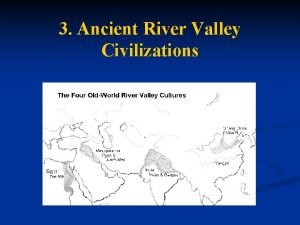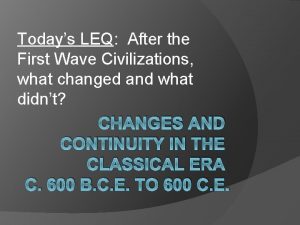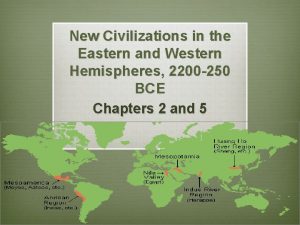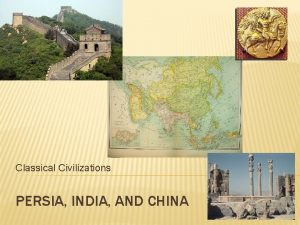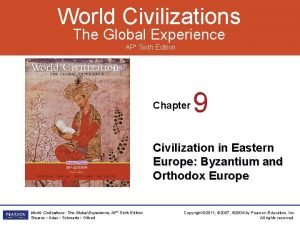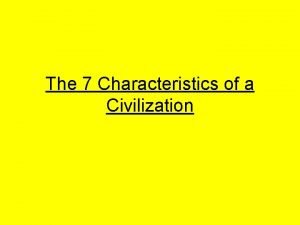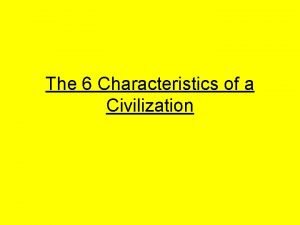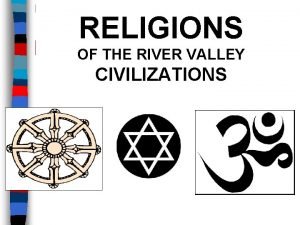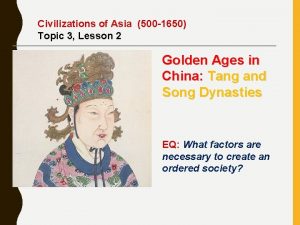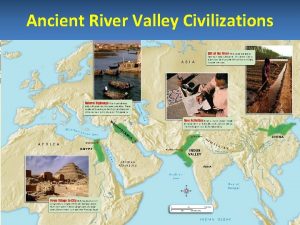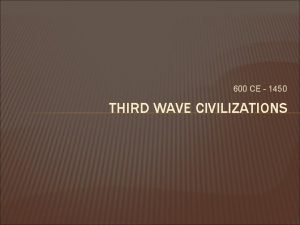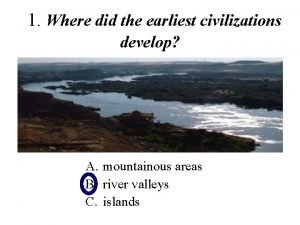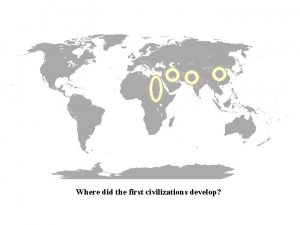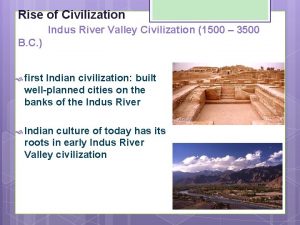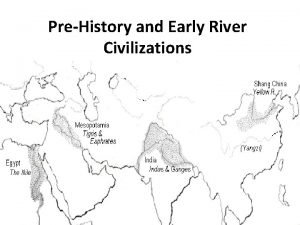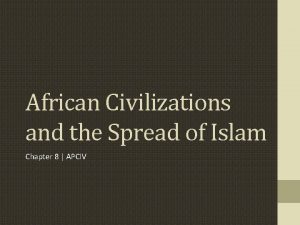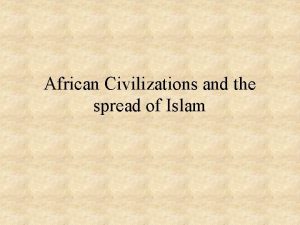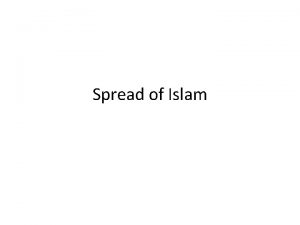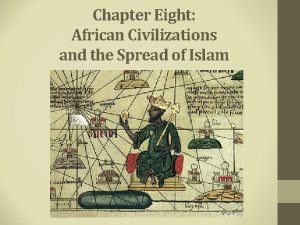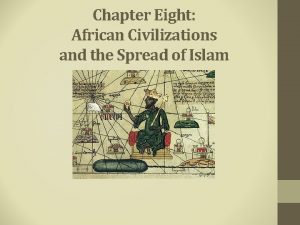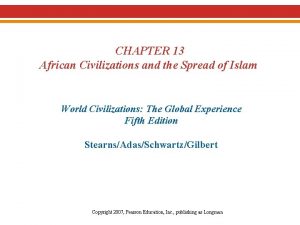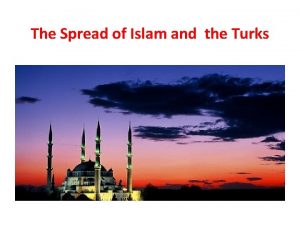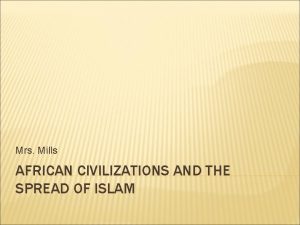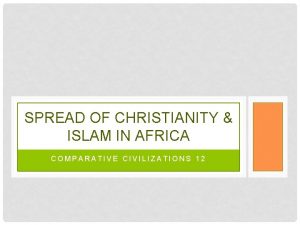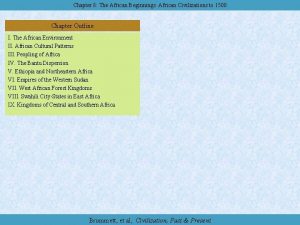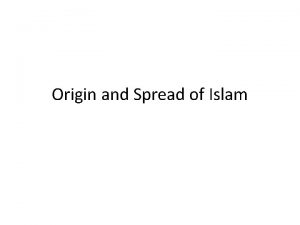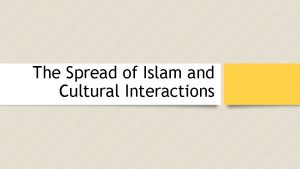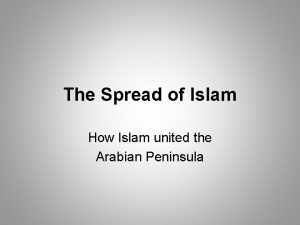African Civilizations and the Spread of Islam Chapter













































- Slides: 45

African Civilizations and the Spread of Islam Chapter 8

African Development • Differences in geography, language, religion, and politics contribute to Africa’s lack of political unity. – No universal states, nor universal religions • Christianity and Islam do find adherents in Africa, sometimes leading to large empires.

Stateless Societies • Organized around kinship • Lacking the concentration of political power and authority normally associated with the “state” • Little need to tax the people…encouraged people to move to other sparsely populated areas to create their own community. • External pressures make some of them move into state-building i. e. warfare(ex. pressure)

Common Elements… • Bantu migrations offered a linguistic base for Africans – Different dialects • Animism: belief in the power of natural forces personified as spirits or gods or even inanimate objects • Witchcraft/Holy Men

Economics of Africa • North Africa: involved in Mediterranean and Arab Trade system • Sub-Saharan varies from one region to the next

Arrival of Islam • Northern Africa has always been part of the classical world • After the age of the Pharaohs, Egypt was an important part of the Greek Empire, then later in the Roman Empire.

Arrival of Islam • Toward the end of the Roman Empire, Christianity had taken hold in Mediterranean Africa. – Wars between the Vandals and Byzantines disrupt this • Between 640 and 700 CE followers of Muhammad swept across Northern Africa. – Ifriqiya (Africa) for Eastern North Africa and Maghrib for Western North Africa

Arrival of Islam • By 711 CE, Arab and Berber armies had crossed into Spain, defeated in France in 732 CE. – Conversion was fast and easy in North Africa – With Abbasid Empire but eventually breaks into smaller kingdoms (Muslim Kingdoms)

What does Islam offer Africa? • Equality • Islamic tradition of uniting the powers of the state in a ruler reinforces the concept of the African King. • the umma put Africans legally at the same level as the Arabs.

However… • Practices differ considerably at the local level. – Social Stratification(social classes) – Ethnic divisions(tribes) – Gender differences(male/female) • Often led to reformist movements.

North African Christianity • Christian kingdom of Axum, with communities in Nubia and Egypt (Copts). – Copts maintained religious connection with the Byzantine Empire. When Egypt was conquered by the Arabs and converted to Islam, the Copts were able to keep their religion.

North African Christianity • • • The Ethiopian kingdom that grew from Axum was the most important Christian outpost. In the 13 th and 14 th Century, an Ethiopian Christian State emerges. Constant struggle with Christian Ethiopia and Muslim Somalia


Kingdoms of the Grasslands • Merchants and travelers spread the word of Islam from North Africa across the Sahara towards the Savanna on the southern edge of the Sahara called the Sahel • Camels for transportation • Gold from W. African forests

The Grasslands • The SAHEL was the extensive grassland belt at the southern edge of the Sahara. • TRADE: • Exchange gold from the forests of West Africa for salt from the Sahara (or goods from North Africa) • Camels improved trade

The Grasslands • The SAHEL becomes an active “coast” of trade between the forests to the south and North Africa. • States develop along with trading cities to take advantage of their position as intermediaries in the trade. • Their position in the open plains of the dry Sahel also leaves them open to attack and drought.


Ghana • The “first” of the West African Kingdoms • Rose to power in the 3 rd Century CE by taxing the heavy Gold-Salt trade within its borders. • By the 900’s, its rulers converted to Islam and Ghana was at the height of its power. • Almoravid armies invade Ghana in 1076, survives but in declined by 1300’s new states emerge like Mali

Ghana

Common elements in Sudanic States • Patriarch, or council of elders as leaders • areas with peoples of the same linguistic or ethnic background • Subordinates areas were conquered • Rulers were sacred and were surrounded by rituals. • Islam was used to reinforce indigenous ideas of kingship. • Mali and Songhay ex. of Fusion cultures

The West African Kingdoms

Mali • Malinke people • Rulers supported Islam by building mosques, public prayers, and supporting preachers. – In return, sermons would encourage loyalty to the king. – Mali became a model of the Islamicized Sudanic Kingdoms

Mali • Economic base was agriculture • Sundiata: Malinke leader who led towards prosperity as the state of Mali. • The Mansa, or emperor • Crime was severely punished (as evidenced by Ibn Batuta, the Arab traveler). – Security of travelers and trade was a key element to Mali’s success as a state where commerce plays such an important role

Mali • Sundiata dies around 1260 CE. • Of his sucessors, Mansa Musa was the most famous (r. 13121337) – Made pilgrimage to Mecca in 1324

Mali • Towns were like N. Africa but with W. African flavor • “Port” cities flourish like Jenne and Timbuktu/ • By the 14 th century Timbuktu had a population of 50, 000. – Contained a library and university. • 80% of the villagers lived by the agricultural lifestyle.

Songhay • Songhay begins to form around the 7 th century. By 1010, a capital had been established at Geo on the Niger River. – Rulers became Muslim – Dominated by Mali for a while – By 1370’s, had established themselves as an independent state • Under the leadership of Sunni Ali (1464 -1492) the Empire of Songhay began. – Tactical commander – Ruthless leader. – Successors known as askia’s. – Muhammad the Great expanded the borders of the empire. • By the 1600’s, Songhay dominated the central Sudan

Songhay • Remained the dominant power in the region until the end of the 16 th century. • In 1591, a Muslim army with muskets crossed the Sahara and defeated the larger forces of Songhay. • Songhay split up, but other groups experienced success in the Western Sudan

Political Life in the Sudan • Unified states allowed the various communities, clans, and ethnic groups to coexist. • Movement and fusion of populations was constant in the Sudan • Common religion and law provided solidarity and trust to the merchants. • Organized under Muslim concept of a ruler who united civil and religious authority.

Political Life in the Sudan • Formation of large state heightened social differences and made societies more hierarchical. • Islam tended to accommodate pagan practices and beliefs. Large populations of Mali and Songhay never converted. – Many Sudanic states were matrilineal, which is contrary to patrilineal lines of kinship in the Sharia, or Islamic law.

Slavery • Slave trade between Africa and the Islamic World predated the arrival of Islam – Muslims viewed slavery as a stage in the process of conversion. • Slaves were used as domestic servants, laborers, soldiers, eunuchs, concubines. • Concentration on women and children across the Sahel to the East African coast.

The Swahili Coast of East Africa • From the Horn of Africa to modern-day Mozambique lay a string of Islamicized trading cities with contacts from Arabia, Persia, India, and China. • As in the Savanna Kingdoms of West Africa, Islam was slow to reach the general population in East Africa, and when it did, it was a fusion of indigenous beliefs and the new Islamic faith.

East Africa • Coastal cities developed from the mixture of Bantu migrants, as well as with Indonesian seaborne migrants. – Settled on the island of Madagascar, introducing bananas and coconuts. • Coastal villages of fishers, farmers dotted the coast

East Africa • Different Muslim ruling • Zanj: Arabic for the families, but similar East African Coast. language united them th • 13 Century: in trade. urbanized East African – Towns such as trading ports develop. Mogadishu, Mombasa, – Shared Bantu-based and Arabic Influenced Swahili (coastal) language. Malindi, Kilwa, and Zanzibar.

East Africa • Kilwa was wealthy because of its control over Sofala – Access to the Gold produced in the interior – Farthest point south in which Indian ships could reach in one monsoon season • Many port towns were tied to each other in an active trade network. – 1300 s-1400 s: large state sponsored sailing expeditions stopped at the East African coast for ivory, and gold. • After 1431, only the Arabs and Indians continued this trade.

Central/Southern Africa • While the impact of trade and Islam radically altered the West/North/East African “coasts”, Central and Southern Africa was developing on its own trajectory. • By 1000 CE, still small agricultural societies, preliterate, but with great strides in arts, building, and statecraft…without writing.

Artists… • Terra Cotta objects discovered in Nok, in the forests of Central Nigeria dating to 500200 BCE. • Terra Cotta and bronze portrait heads were found among the Yoruba people of Nigeria

The Yoruba and dominated by a ruling family and aristocracy. • Spoke a non-Bantu language and recognized a relationship with the Hausa, who spoke Afro. Asian language. • Small city-states, each controlling about 50 miles. • Highly urbanized. • Agricultural society supported by a peasantry

Benin • • • Similar settlement patterns as the Yoruba can be found among Edo people who formed the state of Benin. Ewuare the Great (r. 1440 -1473) extended Benin’s control from the Niger River to the Coast. The Oba, or ruler, lived in a huge royal compound.

Central African Kingdoms • By the 5 th Century CE, Bantu farmers and fishers reach beyond the Zambezi • 13 th Century, they were approaching the southern end of the continent. • Beyond the scope of Islam • By 1000 CE, many of these groups were forming states.

Kongo • Late Century, the Kongo was forming along the lower Congo River. • Agricultural base, with skills of weaving, pottery, blacksmithing, and carving. 15 th • • Men: – Clearing the forest, producing palm oil and palm wine, building houses, hunting, long-distance trade. Women: – Cultivation, care of animals, household duties, made salt from seawater, collected seashells which were used as currency.

Kongo

Great Zimbabwe • Farther to the east, among the farming and cattle-herding Shona-speaking peoples. • Creation of GREAT stone enclaves to serve as the capital town area. • By the 15 th century, a centralized state had begun to form controlling central Africa to the Indian Ocean.

Great Zimbabwe


Vocabulary Chapter 8 • • Almoravids Bantu Migration Hausa States Kingdom of Kongo Yoruba Stateless Societies Almohadis Sharia • • Sundiata Sunni Ali Benin Axum Zanj Griots Nok Askia Muhammad
 What was the ghazu what was the ummah
What was the ghazu what was the ummah Spread of islam through architecture exit slip
Spread of islam through architecture exit slip Spread betting india
Spread betting india Spread betting islam
Spread betting islam Spread betting islam
Spread betting islam Chapter 9 lesson 1 ancient india
Chapter 9 lesson 1 ancient india Lesson quiz 11-3 civilizations of east asia
Lesson quiz 11-3 civilizations of east asia Chapter 11 section 1 early civilizations of africa
Chapter 11 section 1 early civilizations of africa Pre columbian america lesson 1 answers
Pre columbian america lesson 1 answers River valley civilizations def
River valley civilizations def Chapter 2 early river valley civilizations
Chapter 2 early river valley civilizations Chapter 26 civilizations in crisis the ottoman empire
Chapter 26 civilizations in crisis the ottoman empire Pengertian perundangan islam
Pengertian perundangan islam Matlamat perundangan islam
Matlamat perundangan islam Latar belakang kerajaan abbasiyah
Latar belakang kerajaan abbasiyah Lesson 5 african american culture and politics
Lesson 5 african american culture and politics Map of incas aztecs and mayans
Map of incas aztecs and mayans Kaozheng ap world history
Kaozheng ap world history Chapter 5 african american in the new nation
Chapter 5 african american in the new nation Ancient river valley civilizations map
Ancient river valley civilizations map 4 river valley civilizations
4 river valley civilizations Early south american civilizations
Early south american civilizations River valley civilization map
River valley civilization map What did the olmec live in
What did the olmec live in 3500 bc civilizations
3500 bc civilizations 4 river valley civilizations
4 river valley civilizations Ancient chinese civilization
Ancient chinese civilization Second wave civilizations
Second wave civilizations Mediterranean civilizations location hemisphere
Mediterranean civilizations location hemisphere What was the significance of the metric act of 1866?
What was the significance of the metric act of 1866? The two classical civilizations of ancient india were the
The two classical civilizations of ancient india were the World civilizations the global experience ap edition
World civilizations the global experience ap edition World civilizations the global experience 7th edition
World civilizations the global experience 7th edition What are the 7 characteristics of civilization
What are the 7 characteristics of civilization What are characteristics of civilization
What are characteristics of civilization River valley civilizations religion
River valley civilizations religion Topic 3 review questions civilizations of asia answers
Topic 3 review questions civilizations of asia answers Civilization ppt template
Civilization ppt template Third wave civilizations time period
Third wave civilizations time period Where did the earliest civilizations develop
Where did the earliest civilizations develop Cuneiform alphabet
Cuneiform alphabet Clash of civilizations huntington
Clash of civilizations huntington Clash of civilizations huntington
Clash of civilizations huntington Seasonal winds that dominate india's climate
Seasonal winds that dominate india's climate River valley civilizations map
River valley civilizations map River valley civilizations vocabulary
River valley civilizations vocabulary
